M.J. Mouton’s Book Series Teaches Children About Scientists
By Brad Goins
Southwest Louisiana is an area that’s fertile when it comes to the production of children’s books. Many of these are very readable and very enjoyable.
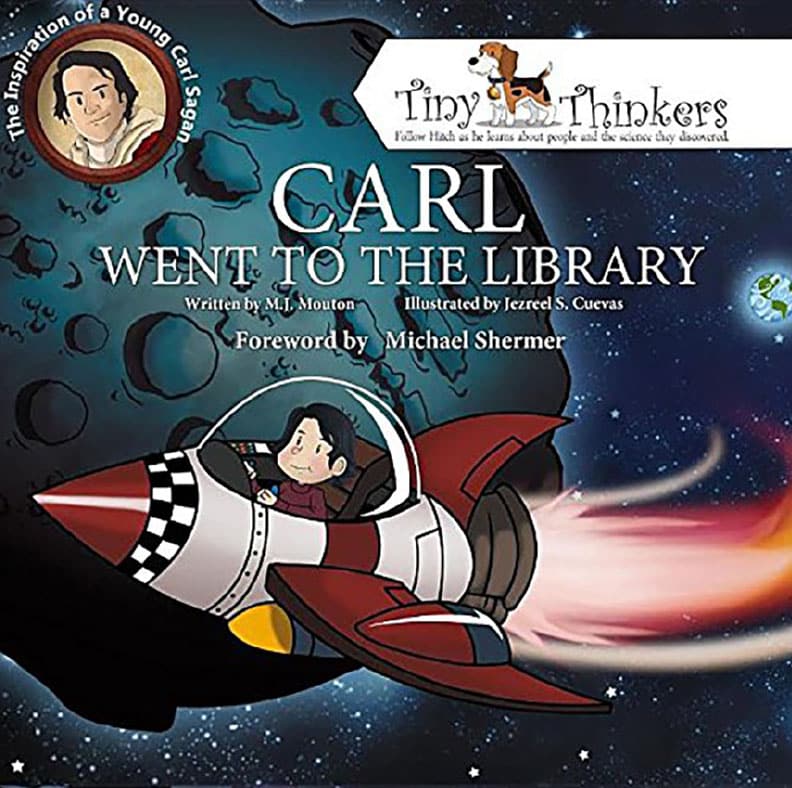
But who would ever have dreamed that a Southwest Louisiana author would write a children’s book about Nobel Prize-winning physicist Richard Feynman?
Longtime Iowa resident M.J. Mouton was the one who dreamed that very thing. His latest children’s book, Richie Doodles, provides a very young person’s introduction to the physics theories of Feynman.
Why put material that is generally thought to be extremely complex in terms children can understand? “All kids like science,” says Mouton. “Kids are natural scientists. I think by encouraging and nurturing that curious nature, you can inspire them to want to learn more.”
Mouton, who’s now in his 40s, says he’s been writing since he was in high school. He’s written more than 40 short books on various scientific topics that have caught his interest over the years. He wrote his little books first of all for his daughter Lylah, then later for his younger daughter Violet.
But the first book he actually published was a 2016 children’s book titled Charlie And The Tortoise, which told the story of Charles Darwin; his voyage on the Beagle; and his theory of evolution.
Mouton felt the topic might not exactly endear him to many in Southwest Louisiana.
He may not have been greatly concerned, since, unlike most Louisiana children’s books, Mouton’s are meant for a national audience. (In fact, the Smithsonian Institute offered to collaborate with him on his books; he begged off, as his current publisher was giving him a more attractive deal.) As an indication of the books’ national sales potential, Charlie And The Tortoise sold 1,600 copies in its first six days on the stands.
Science And Culture
Mouton has spent 23 years working on environmental projects for Environmental Remediations. He’s spent the last 13 years working on the mess that was left behind when a single refinery was closed in 1985. That work is not finished yet.
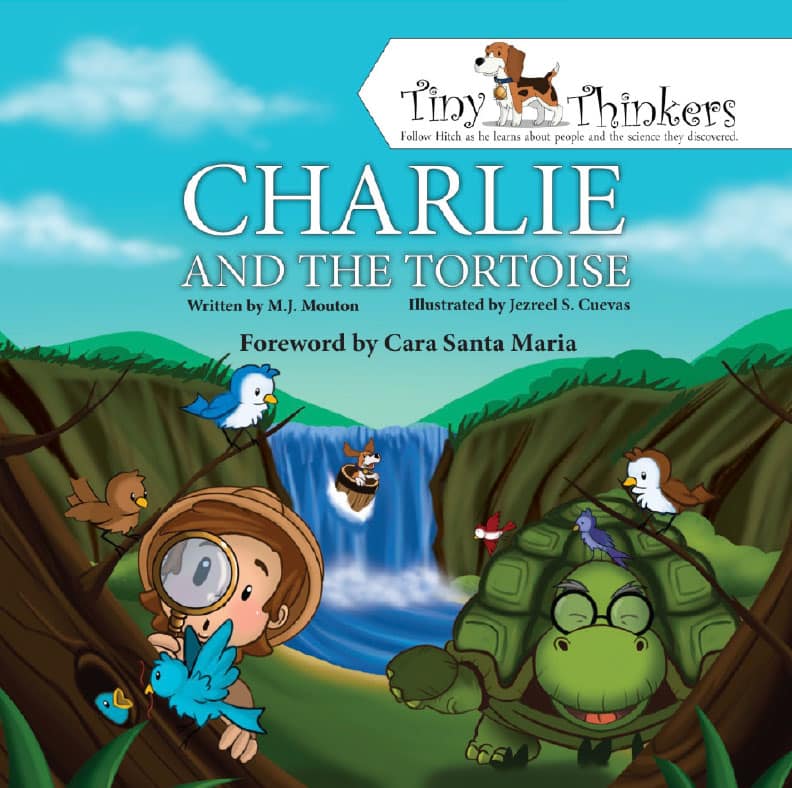
“We’d find fossils; different strata of rock. I’d ask myself, ‘How come they didn’t teach me these things in high school?’”
Most likely, the school was just reflecting the values of the culture of which it was a part. Many educators in this area shy away from (or, in a few cases, actually forbid instruction in) the tough topics of science. Sensing, at some level, that they’re not on the same page as the country’s top scientists, they may also de-emphasize the importance of science in the curriculum.
The attitudes have an effect on the education of those in the area. Mouton says that in Southwest Louisiana, he has met many people who have great intelligence and creativity. “They have extraordinary talents,” he says. But like all people, they are only creatures of their culture and place.
“I know that we have so many smart people, so many gifted artists, writers, mechanics, builders and creative minds that would have excelled in scientific fields if those fields were presented as viable options in the years that they were deciding their future,” says Mouton.
“It’s the general attitude of the people” in the area that makes it hard for them to be objective about the theory of evolution. “Science was never paramount” in the education in the area, says Mouton.
“Some places in the country seem to hold science and math in higher regard, some do not. The single most influential things that curb the direction of a country are its abilities to compete globally in STEM fields, and that country’s ability to be innovators and leaders. Honestly, I hope one of my books inspires a kid to love science. The more kids we encourage to love science and appreciate the math that is needed, the better those kids are positioned to compete.”
I asked if he would encourage his daughters to go to more science-oriented areas when they reached college age. I was surprised when he answered that he wouldn’t. He simply encourages them to be aware of science in their education: to avoid the easy decisions of sliding through science courses or avoiding them altogether.
Richie Doodles
Will Richard Feynman be an easier sell than Darwin to Lake Area readers? Let’s start with just a few words about the great thinker.

Feynman drove a van that had his sub-atomic particle diagrams painted all over the vehicle’s surface (a scene that’s depicted in Mouton’s children’s book).
What’s distinctive about Mouton’s book Richie Doodles is that Feynman makes many of his big accomplishments in physics when he’s a young school student — perhaps a fifth or sixth grader. In Mouton’s children’s books, he says, “all the kids go on some kind of adventures in their minds.”
In the book, when Feynman realizes a human cell has to be magnified 500,000 times before atomic particles can be seen, simple diagrammatic drawings show what Feynman was looking at. He shows his fellow students that when they hold up a thumb, many “tiny particles pass through … without slowing.”
The book’s biggest story is about how young Feynman draws “doodles” to show how subatomic particles connect to each other and repel each other. Mouton emphasizes that Feynman’s “doodles” of particles may be easier to understand than “jumbled up math problems” that show how particles work.
Near the end of the book, an annoyed math teacher expresses her displeasure that a student (not Feynman) is drawing in class. Mouton’s text for the scene goes like this:
“If your teacher sees you doodling in class,
“and says those silly drawings won’t help you pass …
“You can explain that your doodle isn’t silly at all.
“It’s called a Feynman Diagram explaining things that are small.”
Talk about being able to identify with a character … Mouton’s scene is almost eerily similar to one I experienced in high school. An art teacher told everyone in class to make a “doodle.” I quickly drew a simple face. The teacher got downright angry about what I’d produced. “I want a doodle!” she growled. “Something that’s abstract! It’s not supposed to BE anything!”
As I tried two or three times to explain to her that when I doodled, I drew things that I saw, she grew more and more enraged. I finally gave up and drew a few overlapping circles. That was what she wanted, and it enabled her to proceed with her pre-planned group art activity.
I think that’s ample evidence that the things portrayed in Mouton’s book are a true match for what really goes on in school.
A drawing of the books’ ever-present character Hitch the dog can be found at the top of the cover of each Tiny Thinkers book. Hitch the dog can be seen in most scenes in the books. Sometimes he appears to be life size; at other times he’s tiny (for example, when he’s in the basket of a hot air balloon glimpsed through a school room window). Hitch accompanies the young thinkers as they make their adventures in ideas.
‘Just Fun Picture Books’
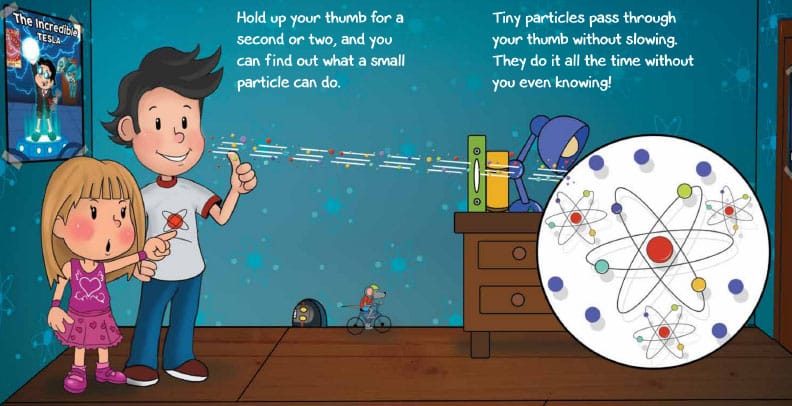
“The book explains that things that we cannot see are always creating a commotion, by their interactions with each other, and all of those tiny things make up everything we see around us …
“Your kid is not going to walk away [from the book] understanding quantum mechanics. But they will understand how small atoms are, and that they are made of smaller things.”
The same methods that are effective in conveying potentially complex material to children are certain to work with adults. “Adults are going to learn so much when they read this to a kid,” says Mouton.
Why Richard Feynman?
Why did Mouton choose Feynman as the second great scientist whose story he’d tell? “He just thought outside the box. If he had a problem, he approached it from so many angles.” Feynman was also famous for asking questions he didn’t have the answer to. He was willing to say, “I don’t know,” and go on examining the question. All these aspects of the physicist are explored in Mouton’s book.
Mouton’s next children’s book, expected in September, is Carl Went To The Library. It will tell the story of famous scientist Carl Sagan. “Carl’s adventure begins with a single question. What is a star?” says Mouton. “He finds that our Sun is a star, and this revelation opens his mind to the size of the universe. He becomes a dreamer.”
Mexican illustrator Jezreel Cuevas depicts all the stories and concepts in the books in digital art paintings. Like Mouton, Cuevas has a love for science and a desire to share that love with the world. While Cuevas’ illustrations are clearly for children’s books, they are a bit closer to adult art than many such illustrations. Cuevas’ use of detail, shading and perspective are all pretty elaborate for this sort of work. He fills the entirety of every frame.
Richie Doodles will hit the stands Feb. 20. You can buy Mouton’s books at Barnes and Noble, Amazon or at indiebound.org.



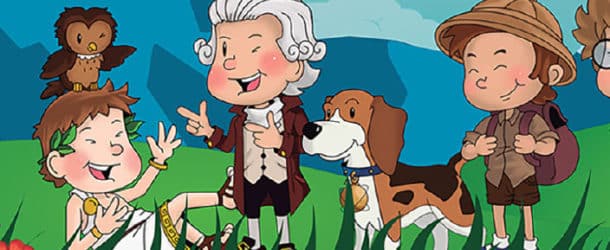
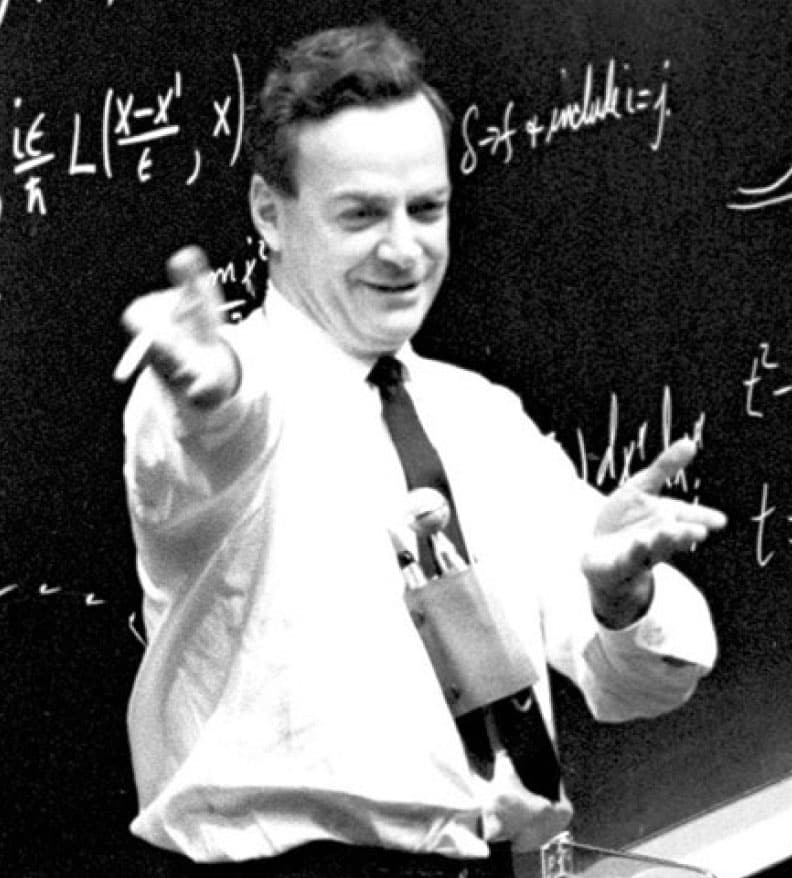













Comments are closed.